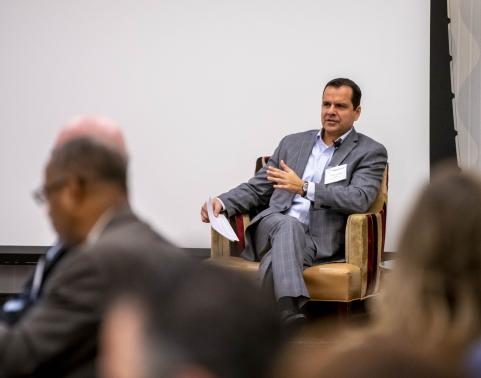PEO EIS’ top leader confirms retirement, shares lessons learned

On Nov. 15, Ross Guckert, the program executive officer at U.S. Army Program Executive Office Enterprise Information Systems (PEO EIS), told a packed room of AFCEA Belvoir luncheon attendees that he will be retiring from federal service in January 2024.
Recalling his early months at EIS, where he has served for 3½ years, Guckert conceded that he faced a huge learning curve given his prior experience at PEOs specializing in weapons systems.
“Many don’t fully grasp or appreciate what EIS does,” said Guckert.
Back when he inherited the portfolio from former program executive officer Cherie Smith, EIS had two separate mission areas that encompassed everything from business systems and data platforms to networks, defensive cyber and enterprise services. Now, with the recent migration of the networks and cyber portfolios to other PEOs, EIS has narrowed its focus with an updated mission to deliver software and services for Soldiers and civilians at speed to transform and modernize the Army.
Guckert described the past 18 months as “really pivotal for our portfolio” with EIS’ adoption of the DOD’s software acquisition pathway and full-scale pivot to Agile.
“By this December, we’re going to look like a completely different organization,” he said.
Over the course of his tenure at EIS, Guckert has gained a lot of nuggets of wisdom. He shared several of his lessons learned with audience members:
- When pursuing Agile transformation, it’s best to do a wholesale organization around Agile — not just in pockets with select programs.
- Getting the functional up-to-speed early on is vital. The proponent office needs to write requirements that can be broken down, so they can be implemented in an incremental fashion.
- It’s helpful to redefine what is expected from the technical services team. To minimize software customizations, original equipment manufacturers should be part of the team.
- Understanding the right metrics for each program is key — how to measure and see oneself, how to look at plans versus actual results, how to look at leading indicators and how to do that every week.
- The unified data reference architecture (UDRA) will help define how to do data centricity and share data across the Army. PEO EIS will be taking over primary responsibility for the business mission area piece of UDRA.
- Effective strategic communications are important to help the Army and industry better understand acquisition organizations. PEO EIS’ decision to incorporate STRATCOMM in its Agile transformation journey has resulted in other PEOs contacting Guckert for Agile-related advice.
Guckert said his top lesson learned was the importance of partnering with industry. Moving forward, EIS will look to industry partners for innovative ideas on how to improve business systems, on artificial intelligence tools, robotic process automation, cyber and data analytics.
“We’re all ears,” said Guckert.
Related News
-
Onedia James: a logistician and leader with a family legacy of service
April 22, 2025Onedia James recently stepped into the role of acting deputy project manager for Army Data and Analytics Platforms (ARDAP) at U.S. Army Program Executive Office (PEO) Enterprise, where she helps oversee and support the data portfolio’s four programs. -
PEO Enterprise’s new PL Digital Market reimagines IT product/service procurement
April 2, 2025FORT BELVOIR, Va. – U.S. Army Program Executive Office (PEO) Enterprise today announced the launch of the Product Lead (PL) Digital Market, which replaces PL Computer Hardware, Enterprise Software and Services (CHESS), effective Apr. 2, 2025. -
Two vastly different Army programs prepare for Software Acquisition Pathway
March 24, 2025At U.S. Army Program Executive Office Enterprise, which is now over two years into its Agile transformation, several enterprise software programs are already in the execution phase of the DOD’s Software Acquisition Pathway, which is designed to facilitate rapid and iterative delivery of software capability to users.
Work for Us
Join a winning team! Search for job opportunities with PEO Enterprise.
Work with Us
Help support important missions. Explore ways your company can work with PEO Enterprise.